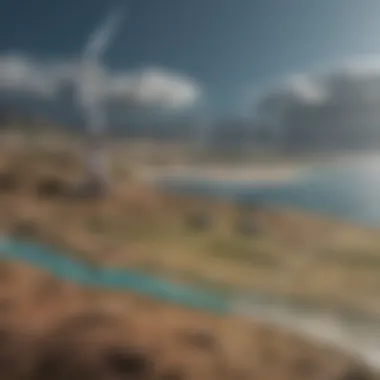The National Wind Map: A Comprehensive Review


Intro
Understanding wind energy potential is essential in the quest for sustainable energy solutions. The National Wind Map serves as a pivotal resource in this context. It is not merely a graphical representation of wind data; rather, it encapsulates complex methodologies, extensive data collection efforts, and analysis techniques. By evaluating various geographical regions, this tool provides insights that are critical for energy planners, researchers, and policymakers alike.
In the coming sections, we will explore the fundamental aspects of the National Wind Map. This includes its creation methodologies, applications in renewable energy planning, and the obstacles that researchers face in data collection and analysis. Through case studies and recent technological advancements, we will uncover the significant impact of wind maps on fostering sustainable energy initiatives.
Moreover, employing such detailed wind mapping allows stakeholders to make informed decisions that optimize wind energy development. The implications stretch beyond energy projects and delve into economic and environmental realms. Ultimately, understanding the National Wind Map becomes a crucial factor in shaping future energy strategies.
Preamble to the National Wind Map
The National Wind Map serves as a foundational instrument in assessing the wind energy potential across various regions. Understanding its significance entails recognizing how it guides investors, policymakers, and researchers in making informed decisions regarding energy resource allocation. This part of the article offers clarity on the definition and purpose of national wind maps and stresses their crucial role in the burgeoning field of renewable energy.
Definition and Purpose
A National Wind Map is a visual representation showcasing the distribution and intensity of wind resources across a specified geographic area. Typically generated using both historical and real-time data, these maps illustrate key variables such as wind speed, direction, and frequency. The primary purpose of this mapping is to enable stakeholders to identify areas with the highest potential for wind energy generation.
Such maps become invaluable for utility companies and project developers when selecting sites for wind farms. Additionally, these tools help streamline the planning process, providing essential insights to fortify decision-making processes. In essence, the National Wind Map serves as a roadmap, guiding efforts to harness wind resources efficiently.
Importance for Renewable Energy
The implications of the National Wind Map extend significantly into the realm of renewable energy. As nations move toward more sustainable energy solutions, understanding wind potential plays a pivotal role.
- Resource Optimization: By pinpointing locations suitable for wind energy, these maps help optimize resource allocation, minimizing investment risks and maximizing return on investment.
- Policy Development: Accurate data from wind mapping supports policymakers in formulating sound regulations and incentives aimed at fostering renewable energy investments.
- Environmental Considerations: Understanding wind patterns aids in assessing the environmental impact of proposed wind farms, mitigating adverse effects on wildlife and local communities.
"A comprehensive wind map can transform how we approach energy planning, ensuring sustainable methods are not only an afterthought but a primary focus."
Methodologies for Creating Wind Maps
Creating accurate and reliable wind maps is essential for understanding the wind energy potential of a region. This process involves various methodologies, which encompass data collection techniques and modeling approaches. Each methodology contributes significantly to the overall quality and utility of the wind map. Effective methodologies ensure that the wind maps serve their purpose in energy planning, site selection, and environmental assessments.
Data Collection Techniques
Data collection is the foundation of any wind mapping project. The quality of data influences the accuracy of the resulting wind map. Various techniques are employed to gather wind data:
- Ground-based Measurements: This approach involves installing anemometers at different heights across various locations. They provide direct measurements of wind speed and direction.
- Meteorological Stations: National and local meteorological stations also provide valuable datasets. These stations often have historical data that can inform long-term wind patterns.
- Remote Sensing Technologies: LiDAR and sodar are prominent technologies. These instruments measure wind profiles from the ground level to several hundred meters above the surface. They are particularly useful in areas where it is impractical to have a large number of ground-based stations.
Through multiple data collection methods, researchers can create a comprehensive dataset. However, the challenge remains to ensure consistency in measurements and calibrations across different instruments.
Modeling and Simulation Approaches
After data collection, the next step involves modeling wind patterns to predict wind behavior accurately. Modeling plays a crucial role in transforming raw data into meaningful insights. Several approaches are common in this phase:
- Numerical Weather Prediction (NWP) Models: These models simulate atmospheric conditions and provide forecasts based on current meteorological data. Utilizing NWP helps understand how weather systems affect wind flow over time.
- Computational Fluid Dynamics (CFD): CFD models analyze wind flow around terrain and structures, providing detailed insights into wind patterns at different heights and locations. This approach aids in anticipating how topography affects wind movement.
- Statistical Models: These models are based on historical data and use statistical analysis to interpret wind patterns. They help in identifying trends and making predictions about future wind behavior.
As each modeling approach has its strengths and weaknesses, combining different methodologies often yields the best results. This hybrid approach increases the robustness of the wind map, allowing for better decision-making in renewable energy planning.
"Accurate wind maps are not just about where the wind blows; they tell us how we can harness that power effectively."
In summary, the methodologies for creating wind maps are intricate yet vital. They form the backbone of any analysis related to wind energy potential, ensuring that stakeholders can make informed decisions in developing renewable energy solutions.
Understanding Wind Patterns
Meteorological Factors Influencing Wind


Understanding the meteorological factors influencing wind is crucial for anyone engaged in the planning and development of wind energy projects. The dynamics of wind arise from various atmospheric conditions, including temperature gradients, air pressure distribution, and the Earth's rotation. These elements collectively contribute to the formation of wind patterns that are studied through meteorological data.
One significant factor is the temperature difference between land and water, which can create local winds. For example, during the day, land heats faster than water, causing air over land to rise and resulting in cooler air from the sea moving in. This type of wind is known as sea breeze and is vital for coastal regions where kitesurfers and extreme athletes often take advantage of these predictable winds.
Moreover, measuring surface pressure and identifying pressure gradients helps in understanding large-scale wind systems like trade winds and westerlies. These winds, which are prevalent in certain latitudes, have implications for energy generation and can inform the placement of wind farms for optimum efficiency. Winds are also influenced by weather systems, such as high and low-pressure systems.
The advancements in meteorological technology, such as Doppler radar and sophisticated weather stations, enhance the accuracy of wind forecasts and allow for real-time data analysis. This meteorological insight not only helps in predicting wind patterns but also provides a framework for designing specific wind energy initiatives to harness these patterns effectively.
Geographical Influences on Wind Flow
Geographical features significantly influence how wind flows across landscapes. The terrain, including mountains, valleys, and bodies of water, can alter wind patterns and intensities. When air moves over varying elevations, it can accelerate or decelerate depending on the topography.
For instance, mountains can create a phenomenon known as the mountain breeze, where cooler air descends at night. This local effect plays a crucial role in determining the viability of wind energy projects in mountainous regions. Understanding how wind interacts with these geographical features enhances site selection for wind farms and informs infrastructure design.
Additionally, urban areas can contribute to localized wind patterns through the urban heat island effect. Buildings can disrupt natural wind flow and create areas of increased turbulence. Knowing such influences allows developers to account for potential variances in wind speeds that can impact turbine efficiency.
In summary, understanding the geographical influences aids in interpreting wind maps accurately, which is essential for designing effective wind energy systems. Various digital tools, including Geographic Information Systems (GIS), help visualize this data, making it easier to see how geography and wind interact.
"Wind patterns are not just random; they are a dance between geography and meteorology, shaping our energy landscape."
Applications of National Wind Maps
The applications of national wind maps serve a critical role in the planning and development of wind energy projects. These maps are complex tools that not only provide data on wind energy potential but also influence various sectors significantly. Understanding their applications offers insight into how wind maps can optimize energy production and guide investment decisions in sustainable practices.
Site Selection for Wind Farms
Site selection is one of the foremost applications of national wind maps. Selecting an ideal location for a wind farm can determine the project's overall success. National wind maps provide comprehensive data on wind speed, direction, and frequency. Analyzing this data allows developers to identify locations with the highest wind energy potential.
When evaluating sites, the wind map can indicate areas that consistently receive strong winds. This information is invaluable as it allows stakeholders to prioritize sites that will yield the best energy output over time. In addition, understanding topographical features and local weather patterns through these maps can help in making well-informed decisions.
Factors to consider in site selection include:
- Wind Resource Quality: This refers to the consistency and speed of wind energy in potential locations.
- Distance to Infrastructure: Proximity to existing power lines and roads can reduce costs associated with infrastructure setup.
- Environmental Impact: Evaluating the ecological sensitivity of a site is crucial. Wind maps can help avoid sensitive habitats.
Policy and Regulatory Frameworks
The creation and management of wind energy initiatives often involve complex regulatory frameworks. National wind maps play a significant role in shaping policies related to wind energy. They provide crucial data that informs lawmakers and regulators about where wind energy projects should be developed.
Policymakers can utilize these maps to:
- Assess Feasibility: By identifying regions with high wind potential, regulatory bodies can allocate resources strategically.
- Develop Incentives: Effective policies can encourage development in areas indicated by national wind maps, promoting investment and innovation.
- Create Zoning Regulations: Wind maps can aid in developing guidelines for where wind farms can be constructed, minimizing conflicts with residential areas or critical habitats.
Ultimately, these frameworks underpin the stability and growth of the renewable energy sector, allowing for sustainable energy solutions based on empirical data.
Infrastructure Planning and Development
Infrastructure planning is another essential application of national wind maps. The data derived from these maps not only informs site selection but also aids in the development of the necessary infrastructure. This involves the construction of roads, transmission lines, and wind turbine installations.
Wind maps can:
- Optimize Transmission Planning: Knowing where wind energy is abundant helps in determining the best routes for transmission lines, minimizing costs and maximizing efficiency.
- Facilitate Maintenance Operations: Identifying wind patterns allows for better planning of maintenance schedules and procedures for wind farm operations.
- Support Local Economic Development: Well-planned wind farms can stimulate local economies by creating jobs and providing new business opportunities in construction and maintenance.
Challenges in Wind Mapping
Understanding the challenges in wind mapping is crucial for the development and effectiveness of national wind energy resources. Accurate wind mapping is foundational for any successful wind energy planning. However, several factors complicate this undertaking. Let's explore some of the prominent challenges in detail.


Data Accuracy and Reliability
Data quality is a major concern when creating wind maps. Wind measurements can vary significantly based on location, time, and methods used for data collection. For instance, utilizing ground-level data alone might not capture the full complexity of wind patterns in an area. Precision in localized wind measurements is vital to determine potential output from wind resources.
Additionally, historical data can be limited or biased, leading to questionable forecasts. If the data collection methods are not standardized, comparison between various regions becomes problematic. To mitigate this issue, continuous monitoring using advanced equipment like anemometers can provide more reliable data sources. Collaborations with meteorological organizations can enhance data validity.
Technological Limitations
While technology has advanced significantly, there are still limitations that affect wind mapping. Traditional tools may struggle to capture high-resolution wind patterns. For example, Doppler radar and satellite setups are complex and may be prohibitively expensive for some regions.
Moreover, software systems used to model wind behavior often depend on simplified assumptions about airflow and terrain. This simplification can lead to inaccuracies in wind predictions. As technology progresses, integrating more sophisticated modeling techniques will be necessary to improve the fidelity of measurements.
Environmental Considerations
Environmental factors also play a critical role in wind mapping. Factors like vegetation, urbanization, and geographical features influence wind flow and speeds. Different terrains can create turbulence, affecting not only wind patterns but also equipment durability.
Environmental impacts must be weighed carefully. Wind farms may disrupt local ecosystems and wildlife habitats. This means that while creating a wind map, assessments of environmental considerations should not be an afterthought. Thorough evaluations can lead to more sustainable wind projects that consider both energy needs and ecological balance.
"The importance of considering environmental aspects in wind mapping is paramount in ensuring sustainable energy solutions."
Innovative Technologies in Wind Mapping
Innovative technologies are reshaping the landscape of wind mapping, enabling more precise and comprehensive insights into wind patterns and availability. As the demand for renewable energy rises, these technologies play a crucial role in optimizing wind energy potential. They not only enhance the accuracy of wind data collection but also streamline the integration of this data into practical applications. This section explores two significant technology domains: Remote Sensing Technologies and Geographic Information Systems (GIS).
Remote Sensing Technologies
Remote sensing technologies involve the acquisition of information about wind patterns without direct contact. These methods utilize various instruments and satellite systems to gather data on atmospheric conditions. The advantages of remote sensing are clear. They provide large-scale data coverage, essential for identifying ideal wind farm locations from regional to national levels.
Key tools in this category include LiDAR (Light Detection and Ranging) and SODAR (Sonic Detection and Ranging). LiDAR, for example, can measure wind speed and direction at different altitudes, giving a clear view of wind shear and its variations. This information proves vital for optimizing turbine placement as it allows developers to better understand vertical wind profiles.
Some considerations come with remote sensing technology. Although it offers substantial benefits, factors such as cost and operational complexity may pose challenges. Understanding the local terrain and atmospheric conditions is necessary to make the most out of remote sensing.
"Remote sensing offers the capacity to gather data efficiently and accurately, creating opportunities for advancing wind energy implementations."
Geographic Information Systems (GIS)
Geographic Information Systems (GIS) represent another innovative technology imperative for effective wind mapping. GIS enables the analysis, visualization, and management of spatial data related to wind resources. This technology aggregates various datasets, allowing stakeholders to pinpoint areas with the highest potential for wind energy generation.
The integration of GIS in wind mapping serves several purposes:
- Data Integration: It combines meteorological data with geographical and environmental information, helping create detailed wind maps.
- Spatial Analysis: GIS tools can identify optimal sites for wind energy projects by analyzing proximity to infrastructure and environmental constraints.
- Scenario Planning: Decision-makers can use GIS to model different development scenarios, assessing potential impacts on local ecosystems and communities.
GIS technology also allows for ongoing monitoring, making it easier to adjust projects as conditions change over time. However, a solid understanding of GIS software and techniques is essential to capitalize on its full potential.
Case Studies of National Wind Maps
The case studies of national wind maps offer a critical perspective on how various countries conceptualize, implement, and utilize wind mapping for energy solutions. These studies are not mere examples; they present the practical applications, successes, and areas of improvement in wind mapping techniques. By investigating these real-world initiatives, we can better understand the multilayered benefits and considerations that come with developing and optimizing national wind maps.
Successful National Initiatives
Many countries have embarked on extensive programs to develop their national wind maps, resulting in significant advancements in renewable energy planning. For instance, the United States has created a comprehensive wind resource map through the Department of Energy. This initiative has not only facilitated site selection for wind farms but also promoted investment in wind energy infrastructure. The mapping incorporates various data collection methodologies, allowing accurate assessments of regional wind patterns.
Similarly, countries like Germany have implemented the "Wind Atlas" project. This initiative focuses on high-resolution spatial data, allowing for a finer granularity in wind resource assessment. Such efforts have propelled Germany into a leading position in wind energy generation in Europe.
"Accurate wind maps substantively enhance the feasibility and efficiency of renewable energy projects."


The case studies from these nations illustrate how national wind maps serve as foundational tools in transitioning to sustainable energy sources. They emphasize the importance of reliable data and innovative technologies in ensuring successful integration of wind energy into national energy grids.
Comparative Analyses of Different Nations
A comparative analysis of national wind maps reveals the strengths and weaknesses endemic to each country's approach. For example, countries with established wind energy sectors, such as Denmark and Spain, have leveraged extensive historical data in their mapping processes. This established tradition allows for more accurate projections and analyses of wind resources, compared to developing nations that may rely on recent technologies or limited data sets.
Moreover, the regulatory frameworks surrounding wind energy also differ significantly. In some nations, supportive policies and incentives lead to proactive mapping initiatives that pave the way for rapid adoption of wind energy. Conversely, countries with restrictive regulations often encounter challenges that hinder the effectiveness of their wind mapping efforts.
The following elements emerge from these comparative studies:
- Data Reliability: Nations with robust data collection techniques show improved wind energy predictions.
- Investment Climate: Countries that encourage investments tend to develop more sophisticated national wind maps.
- Technological Integration: The use of remote sensing and GIS technologies varies, affecting the quality of wind maps.
In summary, case studies of national wind maps are not only instructional but also illuminate the paths various countries have taken in harnessing wind energy. Understanding these patterns and initiatives can drive the further evolution of wind mapping practices across the globe.
Future Developments in Wind Mapping
The landscape of wind mapping is continually evolving, driven by advancements in technology and increasing environmental awareness. The future developments in this domain promise to enhance the accuracy and usability of national wind maps. These improvements are vital for informing policy decisions and optimizing site selection for wind energy projects. By leveraging innovative techniques, stakeholders can gain deeper insights into wind resources, leading to more efficient and sustainable energy generation.
Emerging Trends
Several emerging trends in wind mapping are reshaping the field. One notable trend is the integration of artificial intelligence and machine learning in data analysis. These technologies can analyze vast datasets to identify patterns and predict wind behavior with greater precision.
Additionally, the use of drones for local data collection is becoming increasingly common. Drones can access hard-to-reach areas and provide real-time data on wind conditions. This capability allows for more granular mapping of wind patterns, which can significantly enhance site evaluation for wind farms.
Flexibility in modeling techniques is also a rising trend. As datasets become more complex, new modeling approaches are necessary. Collaborative platforms that allow for data sharing between research institutions, governments, and private companies are gaining traction. These platforms enhance the collective knowledge about regional wind patterns.
Critically, the adaptation to climate change effects is another essential aspect of future developments. Wind mapping must evolve to account for shifting wind patterns caused by global warming. This necessitates not only a reevaluation of existing maps but also ongoing updates to reflect changing conditions.
International Collaborative Efforts
International collaboration plays a significant role in advancing wind mapping. Countries are increasingly recognizing the value of sharing resources, data, and best practices to improve their wind energy strategies. Collaborative projects facilitate the exchange of knowledge and technological innovations among nations.
Organizations such as the Global Wind Energy Council encourage these initiatives. They organize forums and workshops for stakeholders from various countries to discuss their mapping methodologies and technologies. Through these collaborative efforts, countries can learn from each other's experiences, ultimately leading to practical solutions tailored to specific regional contexts.
Moreover, partnerships between academia and industry are pivotal. Universities often drive research on wind mapping methods, while private companies can implement these innovations on a larger scale. This synergy fosters a cycle of knowledge transfer that benefits both sectors.
Ultimately, future developments in wind mapping will rely on embracing cutting-edge technology and fostering international cooperation. These efforts will enhance the effectiveness of national wind maps, driving forward the renewable energy agenda in ways that are both practical and impactful.
"By investing in future developments in wind mapping, we pave the way for smarter decision-making in renewable energy planning."
This forward-thinking approach is essential for capitalizing on wind energy's full potential.
Ending
In this article, we have explored the multifaceted aspects of national wind maps and their critical role in assessing wind energy potential. Wind maps provide essential data that can influence renewable energy planning, guiding developers and policymakers in making informed decisions regarding site selection for wind farms. The intricate methodologies and technologies that create these maps demonstrate a significant advancement in understanding wind patterns and optimizing energy resources.
Summarizing Key Insights
A few key points summarize the insights gained from this exploration:
- Accuracy and Reliability: The effectiveness of a national wind map largely depends on data accuracy. High-quality data improves reliability for stakeholders in the renewable energy sector.
- Applications: Wind maps serve various purposes, from aiding site selection for wind farms to informing policy decisions. Proper interpretation can lead to better infrastructure planning and development.
- Challenges: Wind mapping is not without obstacles. Issues such as technological limitations, environmental considerations, and data collection accuracy must be addressed to enhance the utility of these maps.
"Effective national wind maps are indispensable for maximizing wind energy potential and enabling sustainable energy policies."
By understanding these insights, readers can appreciate the complexity and importance of wind mapping in today's energy landscape.
The Road Ahead for Wind Mapping
The future of wind mapping presents numerous opportunities for development. As the demand for renewable energy grows, improvements in technology will play a crucial role.
- Emerging Technologies: Advancements in remote sensing and geographic information systems (GIS) offer new possibilities for collecting and analyzing wind data. These technologies can enhance the precision of wind maps, making them indispensable tools for energy developers.
- International Collaboration: Countries may increasingly share data and methodologies for wind mapping, fostering collaborative efforts in sustainable energy practices.
- Policy Development: The evolution of wind mapping could lead to improved regulatory frameworks. By facilitating evidence-based policy decisions, national wind maps can help transition to cleaner energy sources more swiftly.







